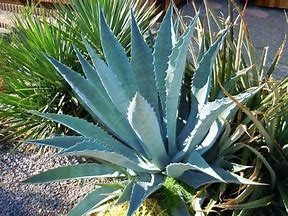
Tequila: So many choices, so little time
There is only one country on the planet where you can legitimately make Tequila, and it is Mexico! Unlike vodka, gin, and rum that can be made anywhere, Tequila belongs to Mexico. The regions within Mexico where the product can be produced: Jalisco (includes the town of Tequila), 8 municipalities in Nayarit, 7 municipalities in Guanajuato, 30 municipalities in Michoacán, and 11 municipalities in Tamaulipas.
Tequila has a Mexican DOC (designation of origin) respected in 40+ countries and is protected through NAFTA in Canada and the US and through bilateral agreements with individual countries such Japan and Israel. It has been protected in the EU since 1997.
Mescal is not tequila! It is made from a different type of agave, the Agave potatorum, which grows primarily in the state of Oaxaca; however, the law states that it can also be made in Guerrero, Durango, Luis Potosi and Zacatecas. Most producers use a simple fermentation and distillation process.
Tequila Process
While new entrants to the Tequila industry are finding creative ways to produce this appealing beverage more efficiently (and effectively?), the old-fashioned way (that dates back at least 100 years) requires all brick ovens, wood fermenters, copper pot stills and tahonas (enormous stone wheels used to roll over and crush cooked agave). In modern plants the tahonas has been replaced with shredding machines, fast autoclaves have replaced brick ovens with stainless steel stills and fermentation tanks are usual part of the factory inventory.
Tequila is a subcategory of mescal that is distilled from blue weber agave, a spiky plant (and a member of the lily family) that must be 5-12 years of age before it is harvested. The leaves are cut off and the heart of the agave (pina) is baked in brick ovens or autoclaves, then it is shredded and rinsed with water to release the sugars which are then fermented and distilled.
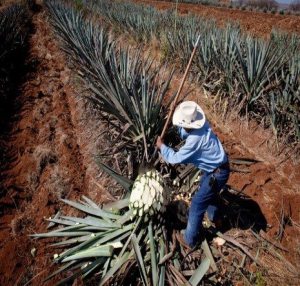
Tequila must be grown and distilled within a specific region of Mexico, either the highlands or the lowlands, in the state of Jalisco. Highland Tequilas (blue agaves that are larger is size) tend toward citrus fruit and vegetal pepper notes on the palate while lowland Tequilas are frequently herbaceous, with tropical fruit and mineral notes. The red volcanic soil around the city of Tequila is desirable for growing the blue agave. More than 300 million plants are harvested each year.
Tequila must have an alcohol (aka ethanol) content of at least 38 percent (76 US proof) for domestic consumption but can be produced at an alcohol level between 31-55 percent (62-110 US proof). By US law, tequila must contain at least 40 percent alcohol (80 US proof) to be sold in the US domestic market.
Age is Desirable
Tequila is sold as either blanco or plata (unaged or aged up to 2 months), reposado (2 months to 1 year), anejo (1-3 years) or extra-anejo (3+ years). If it is labeled as joven or gold, it is usually unaged with a yellow color.
History. Be the First
Tequila production started in the 16th century near the city of Tequila. Originally known as pulque (a fermented beverage made from the sap of the agave plant), it was consumed in pre-Columbia central Mexico before it developed a European following. The milk-like beverage was so popular that the Aztecs worshipped 2 gods identified with the spirit: Mayahuel, goddess of the maguey and her husband Patecatl, the god of pulque.
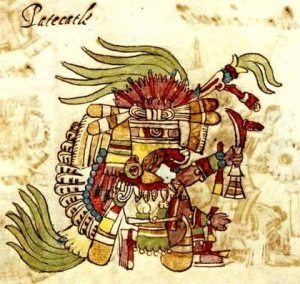
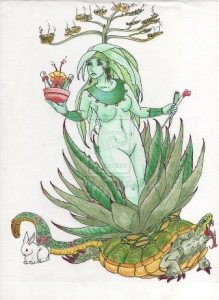
The Spanish conquistadors defaulted to this beverage when they ran out of brandy and began to distill the plant to produce one of North America’s first indigenous distilled spirts.
At the beginning of the 17th century local families began making the beverage and King Carlos IV of Spain permitted the Cuervo family the first license to commercially make tequila. Don Cenobio Sauza, the founder of Sauza Tequila was the first to export tequila to the US and Don Francisco Javier is known for insisting that “there cannot be tequila where there are no agaves.” His efforts are responsible for the current requirements that protect the Tequila designation.
Explain the Label:
1. Type (Tipo). Blanco, Gold, Reposado, Anejo, Extra-Anejo, Reserva de Casa (limited edition bottling)
2. Purity: 100 percent agave (labeled). If less than 100 percent – it is Mixto
3. NOM. Distiller registration number. Used to distinguish more than 500 brands from approximately 70 distillers. NOM is not an indicator of quality!
4. CRT. Tequila Regulatory Council. Certifies products. NOT a guarantee of quality – only that it is produced legitimately
5. DOT. Denomination of origin number. The product is in compliance with Mexican regulations regarding production. It may not appear on all labels
6. Brand name. Does not indicate who makes the product (see NOM)
7. Alcohol content. Tequilas produced in Mexico are usually 38-40 percent alcohol (76-80 percent proof); can be legally higher (up to 50 percent or 100 proof).
Calorie Count
| Hard Liquor | Calories Per Ounce | Per 1.5-oz Serving |
| Vodka | 69 | 104 calories, 0 g carbs |
| Cognac | 69 | 104 calories, 3 g carbs |
| Tequila | 69 | 104 calories, 8 g carbs |
| Gilbey’s® Gin | 79 | 119 calories, 0 g carbs |
Info from sparkpeople.com
Learn through Drinking
Since it is impossible to discover the nuances of tequila by reading about it, I had the good fortune to attend a tasting recently held in Tribeca at the Anejo Restaurant, noted for its extensive tequila list and small-plates Mexican cuisine. The space was perfect for a cold, damp Manhattan evening where the streets are empty, and the crowds are either hovering at the nearby hotel or in the subway.
Agave Education and Tasting Forum

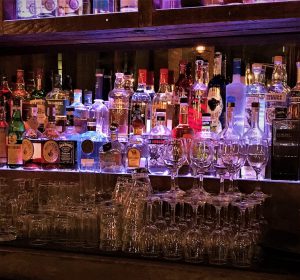

For the Love of Agave, organized by Anthony Joseph, GM, in cooperation with his on-premise tequila expert, Amanda Swanson, drew scores of people willing to brave the horrid weather in order to taste their way through 20+ tequilas and mescals and nibble on appetizers prepared by Executive Chef Ricardo Camacho.
Tequila Curated
• Milagro
Milagros are religious folk charms traditionally used for healing purposes and Milagro Tequila is definitely a cure-all for whatever is troubling or disturbing your persona.

Milagro Anejo Barrel Reserve Tequila (which ranks near the top of the product line) is made in Mexico from 100 percent estate grown Blue Agave that is hand-picked for quality. The product is aged 3-years in new French single oak barrels and arrives in a hand-blow crystal bottle (with a cork). Priced (online) at $109.99.
Milagro Silver, made from 100 percent estate grown and hand-picked Blue Agave is roasted in clay ovens, distilled 3 times delivering a smooth quality that is memorable and budget- friendly (priced online at $26.99).
• Tanteo
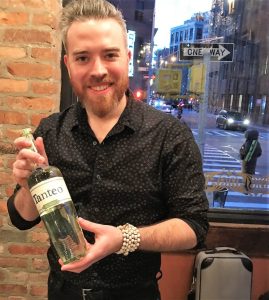

Tanteo starts with ultra-premium blanco tequila and adds locally sourced fresh jalapeno peppers. Tanteo Jalapeno Tequila is designed for making Jalapeno Margaritas and to bring spiciness to all cocktails. Tanteo products are distilled, infused and bottled by hand in the hills of Jalisco, Mexico. At the International Wine & Spirit Competitions (2010, 2012), Tanteo Jalapeno was awarded Bronze medals.
• Tequila Ocho (translates to “8”)
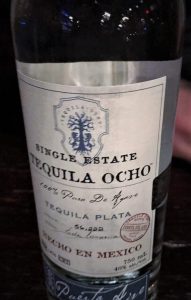
Tradition is the foundation for the Tequila Ocho story. Since 1937 the Camarena family have been tequila producers. The product is made in the slow, artisanal way from agave grown in estate fields. Production is small –batch and each comes from a different field or rancho, delivering distinctive characteristics of “place.”
The importance of “Ocho”
• It takes an average of 8 years for the agaves to ripen before harvesting
• About 8 kilograms of agave are needed to make 1 liter of Ocho tequila (high based on industry average)
• Takes 8 days from agave harvest to becoming blanco (unaged tequila)
• Carlos Camarena has 8 brothers and sisters
• The Camarenas are in their 8th decade of producing tequila
• Ocho Reposado aged for 8 weeks and 8 days
• Espolon
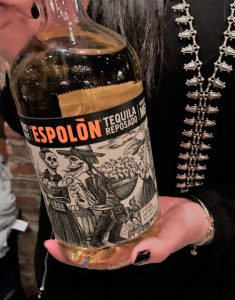
Tequila El Espolon is a Campari America brand and the 6th largest spirits industry in the USA. Produced by the San Nicolas Distillery in the Los Alton (Highlands) region of Jalisco, Mexico, the Master Distiller is Cirilo Oropeza and the product is named for the spur of the rooster (found on the back of the rooster’s leg), an important part of Mexican pride. The distillation process includes the use of American oak barrels with each agave heart cooked for 20-22 hours and distilled for 5.5 hours.
• Mezcales de Leyenda
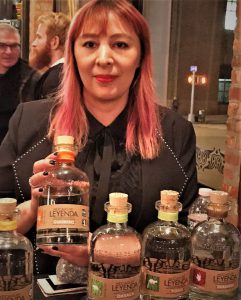
This is the first company to offer artisanal mezcales that are produced from different agaves that are characteristic to each region within the Mezcal DOC (including Oaxaca, Guerrero, Durango as well as other states) and made by local maestro mezcaleros using agave hearts cooked in traditional earthen fire pit ovens and crushed by tahona and then fermented in wood vats and slowly double-distilled in copper pot stills. All products are certified organic by the USDA and the California Certified Organic Farmers.
Carry an Empty Flask
The event also made tequila tasting experiences available from: Herradua, Foraleza, Codigo, El Huho, Del Maguey, Siete Leguas, Mezcal Vao, Guentesca, Arte NOM, and Goza
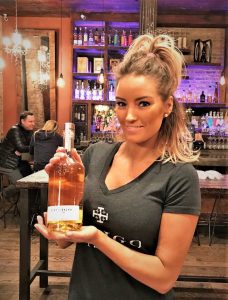
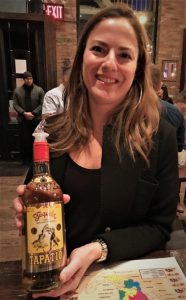
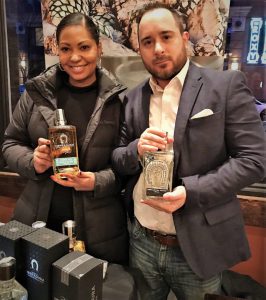
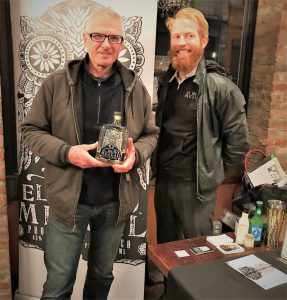
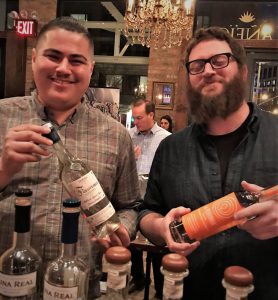
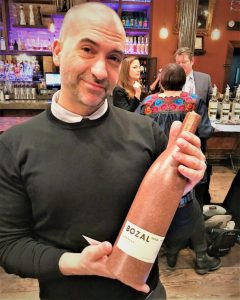
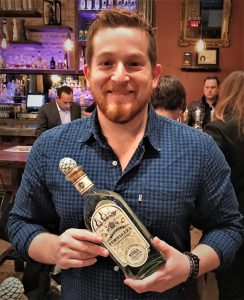
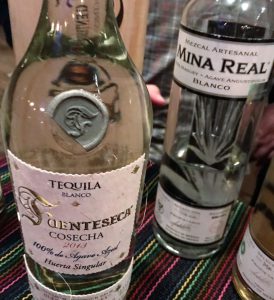
GM Anthony Joseph promised on-going Tequila events – so get your name on the list for updates: [email protected]
© Dr. Elinor Garely. This copyright article, including photos, may not be reproduced without written permission from the author.
